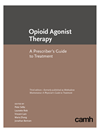Text adapted in 2023 from "Opioid Use and Opioid Use Disorders" in The Primary Care Addiction Toolkit. Available online only.
Components of a clinical assessment
A comprehensive assessment confirms a diagnosis of opioid use disorder. It looks at the patient’s relationship with opioids and involves a combination of patient history, physical examination and urine drug testing, although that test is not necessary (Busse et al., 2017; Centre for Effective Practice, 2018a). The assessment also identifies medical, psychiatric and social issues that may affect treatment and outcomes.
Taking a patient history
Substance use history:
- Obtain a detailed history of opioid use including amount, frequency, route and source of opioids.
- Ask about use of alcohol, tobacco and other substances.
- Ask about overdose history. Also ask about risk factors, such as using substances alone, injecting substances and having limited access to sterile supplies and safe injection sites.
Psychiatric history:
- Cover current and past psychiatric history, and family history of psychiatric diagnoses:
- Chronic opioid use can lead to depression and anxiety through a direct organic effect. This is common in patients who are taking high doses of sedating substances such as opioids, alcohol or benzodiazepines.
- Unhealthy opioid use can lead to depression by causing problems with relationships, finances and other aspects of the person’s life. It is not uncommon for a patient with an opioid use disorder to say, “If I don’t get treatment, I will kill myself.”
Pain history:
- Cover pain diagnoses, past investigations and current medications, and rule out red flags requiring urgent referral.
- Determine the pattern of opioid use (binge, scheduled, as needed).
- Determine the analgesic effectiveness of the current opioid dose (rate the patient’s pain before and after the dose is administered).
- Investigate the psychoactive effects of the current dose. Patients who show signs of addiction find that opioids relieve anxiety and depression and induce a sense of calm, peace and energy.
- Ask about withdrawal symptoms:
- How long has the patient been able to go without opioids?
- Was the patient uncomfortable during this period?
- Has the patient ever used opioids to avoid withdrawal or relieve withdrawal symptoms?
- Determine whether the patient is experiencing withdrawal-mediated pain. Consider withdrawal-mediated pain in patients who report:
- intense magnification of their pain as the opioid wears off
- diffuse myalgias (“pain all over”)
- dysphoria
- evere pain and withdrawal symptoms in the morning, with quick relief after taking the opioid.
- Be alert for drug-related aberrant behaviours (e.g., double doctoring; obtaining opioids from family, friends or on the street).
Psychosocial history:
- Ask about living arrangements, family/social support, family obligations, relationships, work status, sleep.
- Ask about daily functioning (e.g., family, work) before and after the patient started opioids, and also ask about impairments.
- Ask about problems related to opioid use at home, at work or during social interactions (e.g., interpersonal conflicts, inability to complete tasks at work, frequent absences).
Conducting a physical examination
- Injection opioid use: check for needle marks in the antecubital fossa, hands, feet, groin and neck.
- Opioid intoxication: check for pinpoint pupils, nodding off, drowsiness, sweating.
- Opioid withdrawal: check for restlessness, piloerection, sweating, lacrimation, sniffles, dilated pupils, muscle tenderness, tachycardia, hypertension.
- Liver disease: check for jaundice, hepatosplenomegaly, stigmata of chronic liver disease, ascites.
Using other sources to inform the assessment
- Interview the patient’s partner or another close family member (if possible and if indicated, with the patient’s consent) for corroborative history because they may be the first to notice opioid-related problems:
- Do not interview the patient’s partner if you have concerns about partner abuse.
- Preserve patient confidentiality by conducting the interview with the patient present (implied consent) or by getting their written consent.
- Contact the patient’s previous family physician, if possible and with the patient’s consent, because they may reveal clinically important information.
Laboratory investigations
- Order blood tests to confirm the presence of liver disorders: CBC, AST, ALT, GGT, hepatitis B and C serology, HIV.
- Elevated ALT and positive hepatitis C antibodies suggest past or present injection drug use.
- Elevated GGT and MCV often indicate problematic alcohol use.
- Consider screening for sexually transmitted infections and pregnancy, if indicated.
- Consider urine drug testing, which can reveal diversion, non-compliance or another substance use problem.


